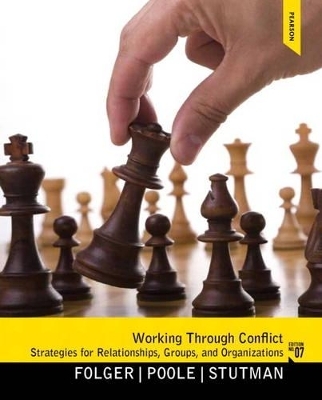
Working through Conflict
Pearson
978-0-205-86092-0 (ISBN)
- Titel ist leider vergriffen;
keine Neuauflage - Artikel merken
Packages
Access codes for Pearson's MyLab & Mastering products may not be included when purchasing or renting from companies other than Pearson; check with the seller before completing your purchase.
Used or rental books
If you rent or purchase a used book with an access code, the access code may have been redeemed previously and you may have to purchase a new access code.
Access codes
Access codes that are purchased from sellers other than Pearson carry a higher risk of being either the wrong ISBN or a previously redeemed code. Check with the seller prior to purchase.
--Updated in its 7th edition, Working Through Conflict provides an introduction to conflict and conflict management that is firmly grounded in current theory, research, and practice, covering the whole range of conflict settings (interpersonal, group, and organizational). Encompassing a broad spectrum of theoretical perspectives, the text includes an abundance of real life case studies that illustrate key concepts and help students learn how to apply theory. The book’s emphasis on application of concepts makes it highly accessible to students, while expanding their understanding of both conflict theory and practical skills.
List of Cases
Preface
Introduction
I.1 Conflict Defined
I.2 Arenas for Conflict
I.3 Productive and Destructive Conflict Interaction
I.4 Judgments About Conflict Outcomes
I.5 Plan of the Book
I.6 Summary and Review
1 Communication and Conflict
1.1 A Model of Effective Conflict Management
1.2 Properties of Conflict Interaction
1.3 Summary and Review
1.4 Conclusion
2 The Inner Experience of Conflict
2.1 The Psychodynamic Perspective
2.2 Emotion and Conflict
2.3 Social Cognition and Conflict
2.4 The Interaction of Psychodynamics, Emotion, and Social Cognition in Conflict
2.5 Summary and Review
2.6 Conclusion
3 Conflict Interaction
3.1 Stages of Conflict
3.2 Interdependence
3.3 Reciprocity and Compensation
3.4 Framing Issues in Conflict Interaction
3.5 Social Context and the Coordination of Meaning
3.6 Social Identity and Intergroup Conflict
3.7 Summary and Review
3.8 Conclusion
4 Conflict Styles and Strategic Conflict Interaction
4.1 Origins of Conflict Style
4.2 What Is a Conflict Style?
4.3 An Expanded View of Conflict Styles
4.4 Determining the Styles of Others
4.5 Pairings of Conflict Styles
4.6 Shifting Styles During Conflict Episodes
4.7 Selecting Conflict Styles
4.8 Cultural and Gender Influences on Conflict Styles
4.9 Styles and Tactics in Practice
4.10 Summary and Review
4.11 Conclusion
5 Power: The Architecture of Conflict
5.1 Power and the Emergence of Conflict
5.2 A Relational View of Power
5.3 Power and Conflict Interaction
5.4 The Use of Power in Conflict Tactics
5.5 The Balance of Power in Conflict
5.6 Working with Power
5.7 Summary and Review
5.8 Conclusion
6 Face-Saving
6.1 The Dimensions of Face
6.2 Face Loss as It Relates to Face-Saving
6.3 A Threat to Flexibility in Conflict Interaction
6.4 Conflict Interaction as a Face-Saving Arena
6.5 Face-Saving Frames in Conflict Interaction
6.6 Face Saving in Other Cultures
6.7 Face-Giving Strategies
6.8 Working With Face-Saving Issues
6.9 Summary and Review
6.10 Conclusion
7 Climate and Conflict Interaction
7.1 Climate and Conflict
7.2 Summary and Review
7.3 Conclusion
8 Managing Conflict
8.1 Review of the Normative Model for Conflict Management
8.2 Navigating Differentiation
8.3 A Procedure for Managing Conflicts
8.4 Addressing Severe Challenges to Conflict Integration
8.5 Dispute Systems: Managing Conflict within Organizations
8.6 Summary and Review
8.7 Conclusion
9 Third-Party Intervention
9.1 Property 1: Conflict Interaction Is Constituted and Sustained by Moves and Countermoves During Interaction
9.2 Property 2: Patterns of Behavior in Conflict Tend to Perpetuate Themselves
9.3 Property 3: Conflict Interaction Is Influenced by and in Turn Affects Relationships
9.4 Property 4: Conflict Interaction Is Influenced by the Context in Which It Occurs
9.5 Summary and Review
9.6 Conclusion
References
Index
| Erscheint lt. Verlag | 11.6.2012 |
|---|---|
| Sprache | englisch |
| Gewicht | 585 g |
| Themenwelt | Kunst / Musik / Theater ► Theater / Ballett |
| Sachbuch/Ratgeber ► Sport ► Tanzen / Tanzsport | |
| Geisteswissenschaften ► Psychologie ► Sozialpsychologie | |
| Sozialwissenschaften ► Kommunikation / Medien ► Kommunikationswissenschaft | |
| Sozialwissenschaften ► Soziologie | |
| ISBN-10 | 0-205-86092-3 / 0205860923 |
| ISBN-13 | 978-0-205-86092-0 / 9780205860920 |
| Zustand | Neuware |
| Haben Sie eine Frage zum Produkt? |